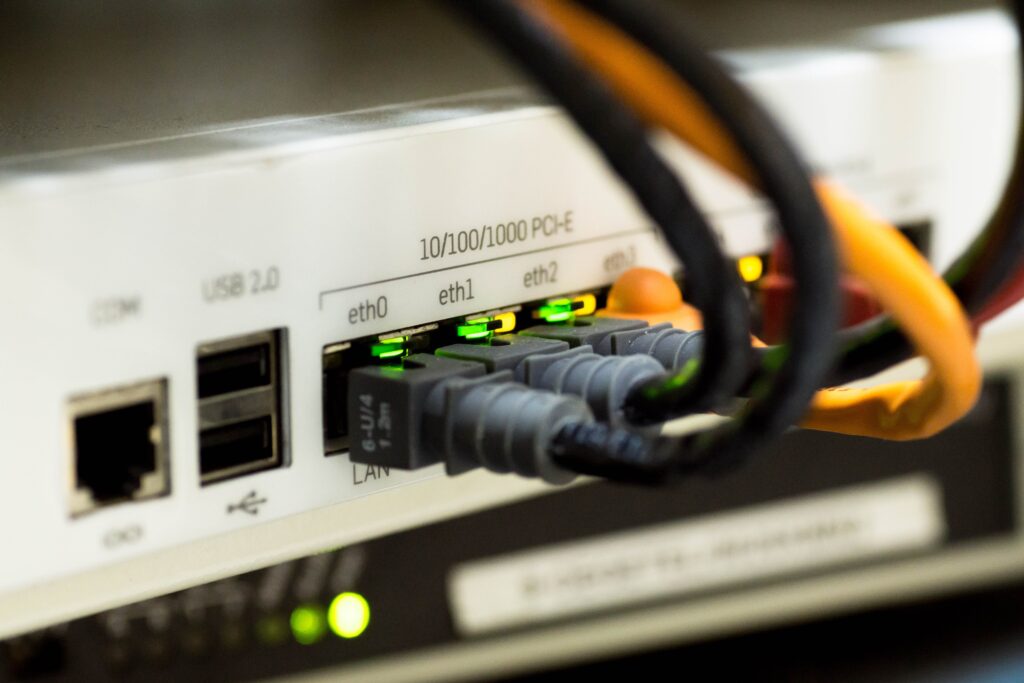
For avid streamers and gamers, an Ethernet cable can enhance speed, reducing buffering and lag. Wi-Fi signals are more prone to interference from physical obstructions or hardware problems, leading to frequent disconnections.
From a security perspective, Ethernet offers a fortified connection; a hacker would need direct access to the cable and router to compromise a device, whereas Wi-Fi traffic is vulnerable to interception since it travels through the air.
Ethernet?
Ethernet is a widely used technology for networking computers, enabling devices to communicate with each other within a local area network (LAN).
Ethernet is a wiring system that is used to connect devices. While the form factor has remained the same, its speed has improved over the years. It makes sense to use an Ethernet connection if your computer setup is stationary—for example if you use a desktop.
You can also plug an Ethernet cable into your laptop if your wireless internet connection becomes unstable, especially during video calls.
However, If you can’t run a wire between two devices, you can use wireless ethernet adapters (WLAN). These devices use high-frequency radio waves to connect devices.
If you want to be as secure as possible when going online, Ethernet is the way to go. However, if you’re using Wi-Fi—and most of us do, especially on mobile devices—it’s worth keeping your connection secure with a VPN.
Wi-Fi
Wi-Fi, signifying wireless fidelity, enables computers, smart devices, and other electronics to wirelessly access the internet within a specific range.
Its advantages are clear: it offers ubiquitous internet connectivity throughout your home, facilitating the use of mobile devices without relying on cellular data plans.
Wi-Fi capably supports everyday activities such as web browsing, social networking, and video conferencing, while also being integral to the functioning of ‘Internet of Things (IoT) appliances, including intelligent lighting systems and refrigerators.
With the rise of remote work, the flexibility to move and work cable-free has become a valued convenience. Wi-Fi technology has seen substantial advancements in speed, and the anticipated launch of Wi-Fi 7 in 2024 is set to deliver breathtaking speeds of up to 30 Gbps.
What distinguishes a Wi-Fi connection from an Ethernet connection?
Speed
Wi-Fi has improved substantially, yet it remains slower than Ethernet. For enhanced internet performance, particularly for avid gamers who seek reduced latency and ping during online play, an Ethernet connection is advantageous.
Selecting the Appropriate Ethernet Cables
Before acquiring an Ethernet cable, consider its category, which dictates supported bandwidth, determine the required length, and assess the necessity of shielding. Shielding, incorporating a conductive barrier, mitigates electromagnetic interference (EMI) that can disrupt the performance of cables with copper conductors.
Security
Ethernet connections, requiring physical cable access, are inherently more secure than Wi-Fi, which broadcasts data through the air and is more susceptible to interception by malicious actors. Employing a VPN can enhance Wi-Fi security by encrypting outgoing data, thereby concealing your personal information and browsing history from unauthorized entities.
Read more on the security risks of hotel Wi-Fi
Dependability
An Ethernet connection offers consistent connectivity, unlike Wi-Fi. Nonetheless, bottlenecks may arise from an obsolete router or network congestion at your ISP. Selecting an appropriate router can mitigate internet speed issues.
Convenience
Wi-Fi connections easily outperform Ethernet in terms of convenience, offering wireless internet access and supporting a plethora of modern devices, thereby enabling a tidier workspace free from cables.
Price
Unless you’re on a metered plan with public Wi-Fi, the cost of using an Ethernet or Wi-Fi connection at home is negligible. Most routers enable seamless switching between Ethernet and Wi-Fi connectivity.
Here are some other ways in which Wi-Fi and Ethernet differ significantly:
| Wi-Fi | Ethernet |
| Delivers a flawlessly integrated internet connection to laptops, tablets, and mobile devices via high-speed airwaves. | Desktops and laptops necessitate a direct physical connection for internet access. For tablets and mobile devices, you may need to procure Ethernet adapters independently, as these are not typically included. |
| The installation and setup process is more efficient and time-saving compared to Ethernet. | The process of cable installation can be intricate and may necessitate the assistance of a skilled technician. |
| Utilizing wireless encryption, such as a password or network key, is mandated. This essential security measure ensures the safeguarding of your private information and prevents potential unauthorized access. | Encryption is not mandatory. However, in the case of wireless encryption, such as a password or a network key, it becomes essential. |
| The speed of internet connectivity is typically slower than that of an Ethernet connection. | The speed of a direct internet connection is typically faster and more reliable than a Wi-Fi connection. |
Selecting Between Wi-Fi and Ethernet
Choosing between Wi-Fi and Ethernet depends on your needs.
Opt for Ethernet when streaming for enhanced stability and speed. Yet, the choice hinges on the device, location, and convenience. For instance, streaming from bed may favor the flexibility of Wi-Fi.
For gaming: Use Ethernet. Wi-Fi can lead to latency issues and unstable connections on desktops or consoles such as Xbox, PS4, or PS5. To mitigate this, connect your device directly with a LAN cable.
For Smart TVs: Ethernet While most smart TVs support Wi-Fi, they also offer Ethernet ports for more stable and dependable wired connections. The reliability can vary with your internet service provider and the quality of your Ethernet cable. The primary benefit of Wi-Fi arises when your TV isn’t positioned close to an Ethernet outlet.
To transmit and download substantial files, use Ethernet for its lower latency and enhanced data transfer rates, surpassing Wi-Fi in efficiency and consuming significant bandwidth.
For casual internet browsing, such as scrolling through social media and streaming videos, a Wi-Fi connection is adequate. When accessing public Wi-Fi, ensure your privacy and data security by employing a VPN, which encrypts your connection, thwarting surveillance from nefarious entities.
in a nutshell, Ethernet surpasses Wi-Fi by offering faster and more reliable connections, with potential speeds up to 10 Gbps using Cat6a cables, resulting in consistently superior internet performance.
4Everproxy adults
FAQ
What distinguishes Powerline technology from Ethernet technology?
Powerline networking ingeniously leverages the pre-existing electrical wiring within a residence or office to disperse data via a powerline adapter. Conversely, an Ethernet connection necessitates a direct cable connection between your router and your chosen device. Powerlines offer an excellent contingency solution in the event of unstable Wi-Fi connectivity or a malfunctioning Ethernet cable. However, it is important to note that powerline adapters may result in elevated latency levels and could occasionally be subject to sporadic interference.
Is it possible to utilize both Wi-Fi and Ethernet simultaneously?
Indeed, the ability to utilize Wi-Fi and Ethernet concurrently is dependent on the type of device you employ. Devices such as desktops or laptops possess the capability to use both simultaneously. However, smartphones or tablets, unfortunately, do not share this feature. To ensure both connections share an equal priority on your desktop, you may need to delicately configure its settings.
Which one delivers higher speed? A 10/100 Ethernet switch or a Wireless-N network?
The speed of your wireless connection can be influenced by several factors, most notably the physical distance between your router and WLAN adapter, as well as the quantity and type of devices simultaneously connected to the network. Nevertheless, theoretically speaking, it is entirely feasible for the wireless connection to surpass the speed of a wired connection under optimal circumstances.
Is it possible for Ethernet connections to be compromised or hacked?
Hacking an Ethernet connection is an arduous task, though not entirely impossible. To fortify the security of your Ethernet connection, it is advisable to employ a robust firewall program. This will act as a formidable barrier, effectively thwarting any unauthorized access to your computer network.

